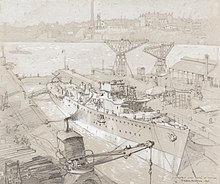HMAS Yarra (U77)
|
|
|
|---|---|

|
|
| period of service | |
| Builder: | Cockatoo Island Dockyards |
| Keel laying: | May 24, 1934 |
| Launch: | March 28, 1935 |
| Commissioning: | December 19, 1935 |
| Fate: | Sunk south of Java on March 4, 1942 |
| Technical specifications | |
| Ship type : | Sloop |
| Displacement : | 1060 ts standard 1370 ts maximum |
| Length: | 79.8 m |
| Width: | 10.8 m |
| Draft : | 2.25 m |
| Drive : | 2 Admirality 3-drum steam boiler Parsons steam turbines with single gear 2000 WPS on 2 screws |
| Speed : | 16.5 kn |
| Range: | 5700 nautical miles at 10 kn |
| Crew : | 135 |
| Armament: | 3 × QF 4-inch ship guns Mk V (3 × 1) 4 × 3-pdr guns 1 MG 2 launchers for depth charges |
The HMAS Yarra (U77) was the second ship of the Royal Australian Navy named after the Yarra River . She was a sloop of Grimsby class during the Second World War . The Royal Navy designated quite slow escort ships primarily for fighting submarines as sloops. Sloops were distinguished from corvettes and escort destroyers by a greater range, which is why they were predestined to accompany convoys even in remote areas.
history
The Yarra was laid on May 24, 1934 in the Cockatoo Island Dockyards , Sydney and put into service on December 19, 1935 by the Australian Navy. Until August 1940, she carried out escort and patrol operations off the Australian coast as part of the 20th mine clearance flotilla. From September 1940 to March 1941 she was used for escort duties in the Red Sea . Her only contact with the enemy was on October 20, when two Italian destroyers attacked a convoy that was escorting the Yarra . During the brief engagement, the Yarra was not damaged, the light cruiser HMNZS Leander and the destroyer HMS Kimberley pursued the retreating Italians and sank the destroyer Francesco Nullo .
From mid-March to April 1941, the Yarra was overhauled in the Bombay Dockyard in Bombay , after which it was used in the Persian Gulf to crack down on the coup of Raschid Ali al-Gailani . Between November and December 1941, she escorted convoys on the dangerous route between Alexandria and Tobruk Fortress , surviving several German air raids. On December 9, 1941, she was finally ordered back to Australia because of the war that had broken out in the Pacific .
After their arrival in the Southeast Asian theater of war in early January 1942 and integration into the ABDA fleet, the Yarra escorted convoys in the area between the Sunda Strait and Singapore . On February 5, she was part of the last convoy to bring reinforcements to Singapore Fortress. During the Japanese air strikes on the convoy, the Yarra shot down a Japanese bomber, but after hits, large fires broke out on the fully loaded troop transport Empress of Asia . The Yarra managed to save 1804 men from the rear of the van and to reach Singapore completely overloaded. Then she towed the incapable of maneuvering destroyer Vendetta to Batavia . There another ship took over the towing task, and the Yarra escorted the tug until it was replaced by the cruiser Adelaide on February 24 .
After that she carried out escort missions while the Allies tried in vain to hold Java. When finally on February 27 the order came to withdraw the supply ships of the fleet from Batavia , the Yarra escorted together with the Indian sloop HMIS Jumna a convoy to Tjilatjap , which they reached at noon on March 2. Once there, however, they were instructed by the commander ashore not to enter due to the Japanese advance. The Jumna should run to Colombo and the Yarra should bring the convoy, consisting of the depot ship Anking , the tanker Francol and the minesweeper No. 51 , to Fremantle . After a day and a half of driving, the small convoy was found by a Japanese task force on the morning of March 4, 1942 at 6:30 a.m. The Japanese association consisted of the heavy cruisers Atago , Takao and Maya and the destroyers Nowaki and Arashi . The commander of the Yarra , Robert Rankin , attempted a desperate counterattack to draw the attackers' fire on the sloop to give the convoy the opportunity to escape. However, the convoy had no chance against the enemy, who was far superior in terms of firepower and speed. At around 8:00 a.m., the Yarra and all the ships in the convoy were sunk. 34 men of the crew rescued themselves on two life rafts, but only 13 of them were still alive when they were found on March 9 by the Dutch submarine K XI .
